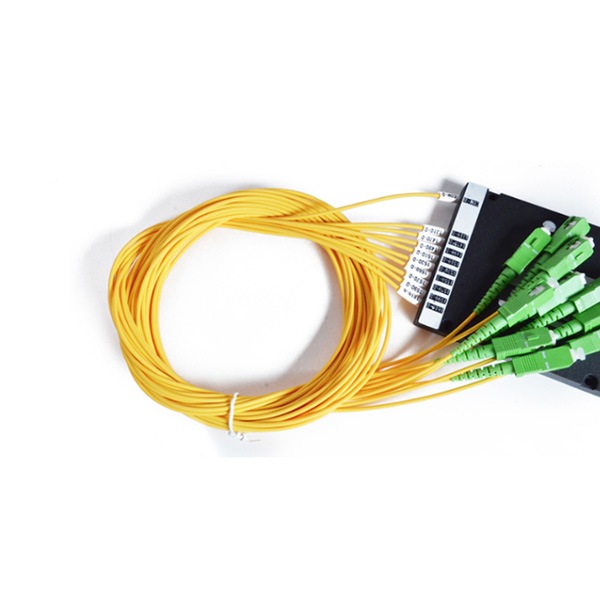WDM technology expands the capacity of fibers by simultaneously transmitting multiple optical signals of different wavelengths in the same fiber, making one fiber act as multiple virtual links.
The core principle of wdm systems is to use the difference in wavelength to distinguish channels:
- At the transmitting end, signals of different wavelengths are combined into a composite signal through a combiner (such as an arrayed waveguide grating);
- At the receiving end, the splitter separates the signals of each wavelength and processes them independently to ensure that the signals do not interfere with each other.
DWDM Technology Types
For efficient capacity expansion, WDM technology is mainly divided into two categories:
Coarse Wavelength Division Multiplexing (CWDM)

The wavelength interval is 20nm, it operates in the 1270-1610nm band, supports 4-18 channelsLow cost wdm, low power consumption (about 0.5 watts/channel), strong compatibilitySuitable for metropolitan area networks or short-distance applicationsIt can expand capacity at low cost based on existing optical fibers without the need to lay additional fibers.
Dense Wavelength Division Multiplexing (DWDM)

The wavelength interval is less than 1.6nm, supporting 8-160 channelsSingle-fiber capacity can reach more than 400GbpsSuitable for long-distance backbone networks; Needs to be combined with dispersion compensation technology to suppress nonlinear effects (such as four-wave mixing).
Specific methods for expanding capacity
Based on industry experience, Yingda recommends the following specific methods for expanding fiber capacity:
Wavelength superposition capacity expansion
By adding new wavelength channels (such as CWDM expansion to 12 waves), the transmission is directly superimposed on the original optical fiber without hardware modification.
Mixed data support
Allow data of different rates and formats to be mixed and transmitted in the same optical fiber, adapt to complex network environments, and improve bandwidth utilization.
Optimize working wavelength
Select low loss wavelengths (such as 1300nm or 1550nm), combine optical fiber parameters (such as attenuation control) to reduce signal loss, and ensure the stability of high-capacity transmission.
Though WDM technology can efficiently utilize existing optical fiber resources and significantly reduce operating costs, but it also needs to overcome the nonlinear challenges of high-power transmission. In future, WDM networking future trends will focus on breakthroughs in single fiber Tbps-level capacity.
WDM Technology FAQ
What CWDM products can you provide?
Yingda manufacturer and wholesale CWDM MUX module, CWDM DEMUX module, CWDM MUX DEMUX module, CWDM OADM module, Compact CWDM module, CWDM fiber chassis, CWDM power meter, CWDM transceiver, CWDM SFP transceivers, etc.
What DWDM products can you provide?
Yingda produce and supply DWDM MUX module, DWDM DEMUX module,DWDM MUX DEMUX module, DWDM OADM module, DWDM optics chassis, DWDM transceiver, DWDM power meter, DWDM laser.
How to purchase WDM products?
Please share your project requirements if you don’t have in mind what exactly products you need, then we check with engineers and get back to you. If you only wanna search cheaper products or find potential suppliers, please share your product list, then we send you quotation sheet fyi.
What is the cost of a WDM system?
CWDM (coarse WDM) uses uncooled lasers and wide wavelength spacing (20nm), with low equipment costs. The total system cost is about 30% of DWDM. It is suitable for medium and short distance scenarios such as metropolitan area networks and enterprise networks, and is a low cost WDM.
DWDM (dense WDM) requires high-precision cooling lasers and precision optical devices, with a wavelength spacing of ≤0.8nm. The equipment cost is high and the deployment is complex. It is suitable for high-capacity scenarios such as long distance backbone networks (backbone long haul WDM).
How to choose a suitable WDM systems?
CWDM is the first choice for short-distance interconnection of small and medium-sized enterprises, DWDM is the first choice for carrier backbone networks and 5G backhaul, and MWDM or OTN integration solutions can be explored for medium-sized metropolitan area networks.
What are the challenges and limitations of WDM technology?
The core limitations of WDM in networking are uncontrollable physical damage (nonlinearity, dispersion), high cost and complexity of operation and maintenance, and poor compatibility of low speed services. In the future, it is necessary to improve management efficiency through OTN integration and promote WDM-PON standardization to reduce costs.

